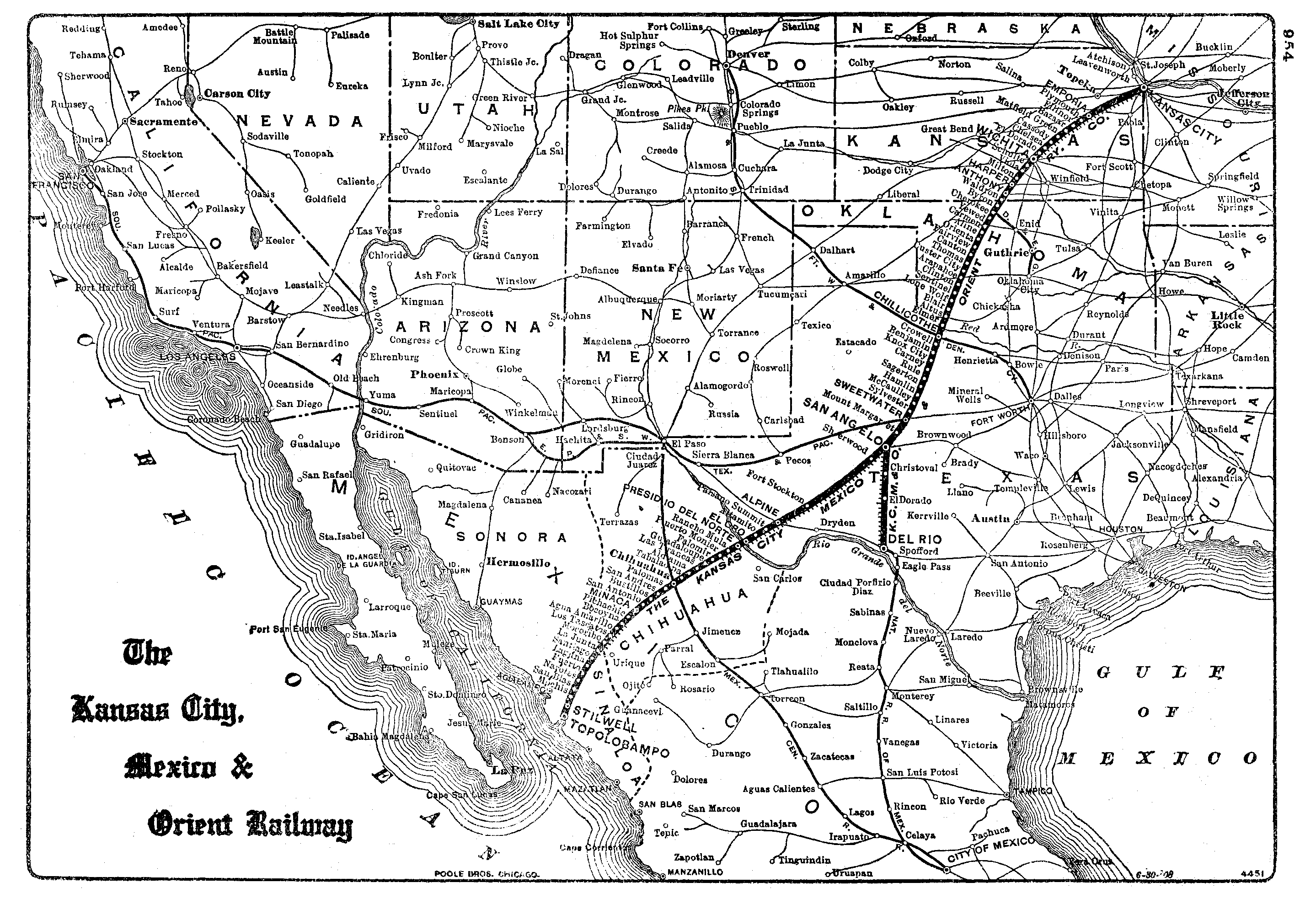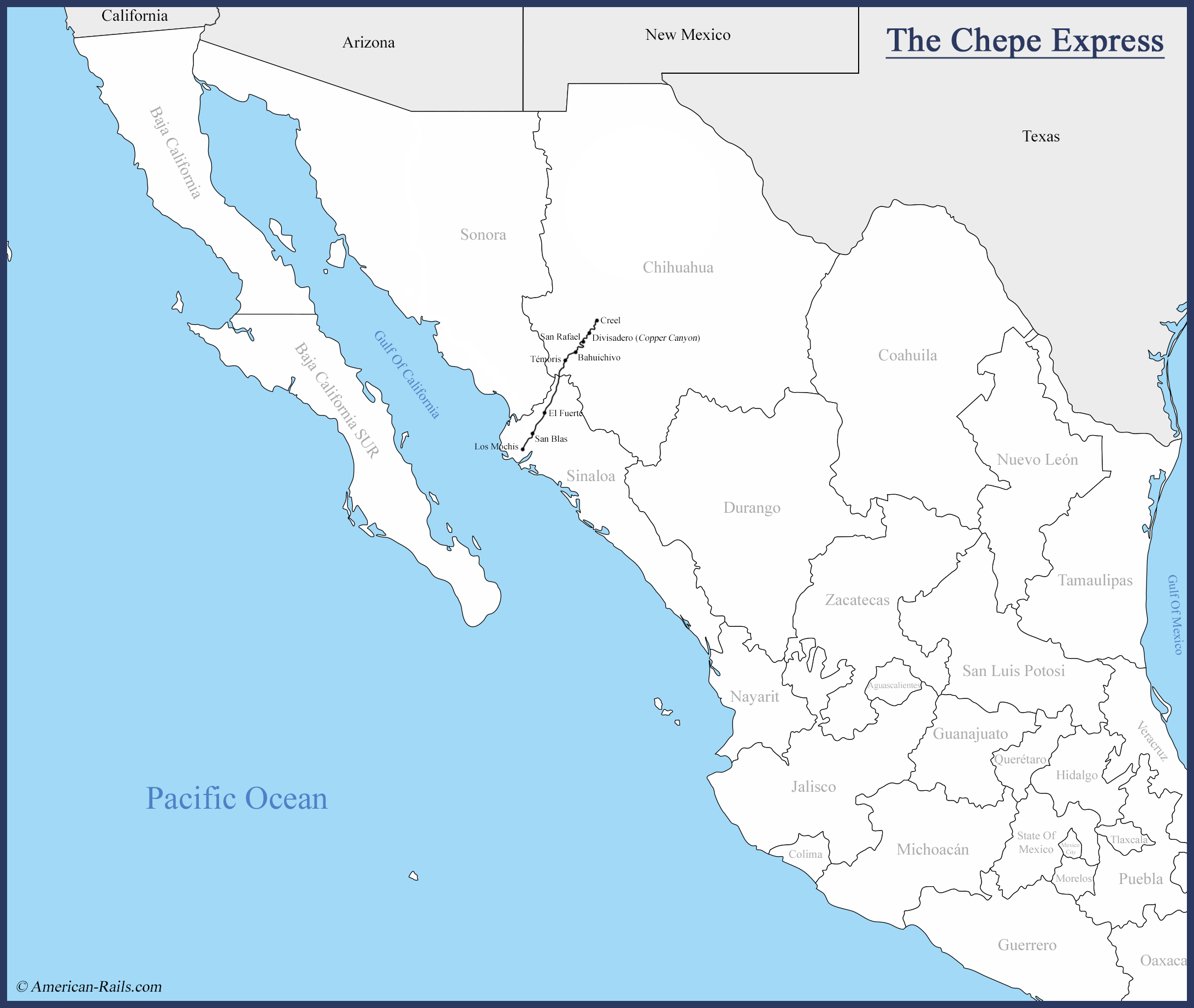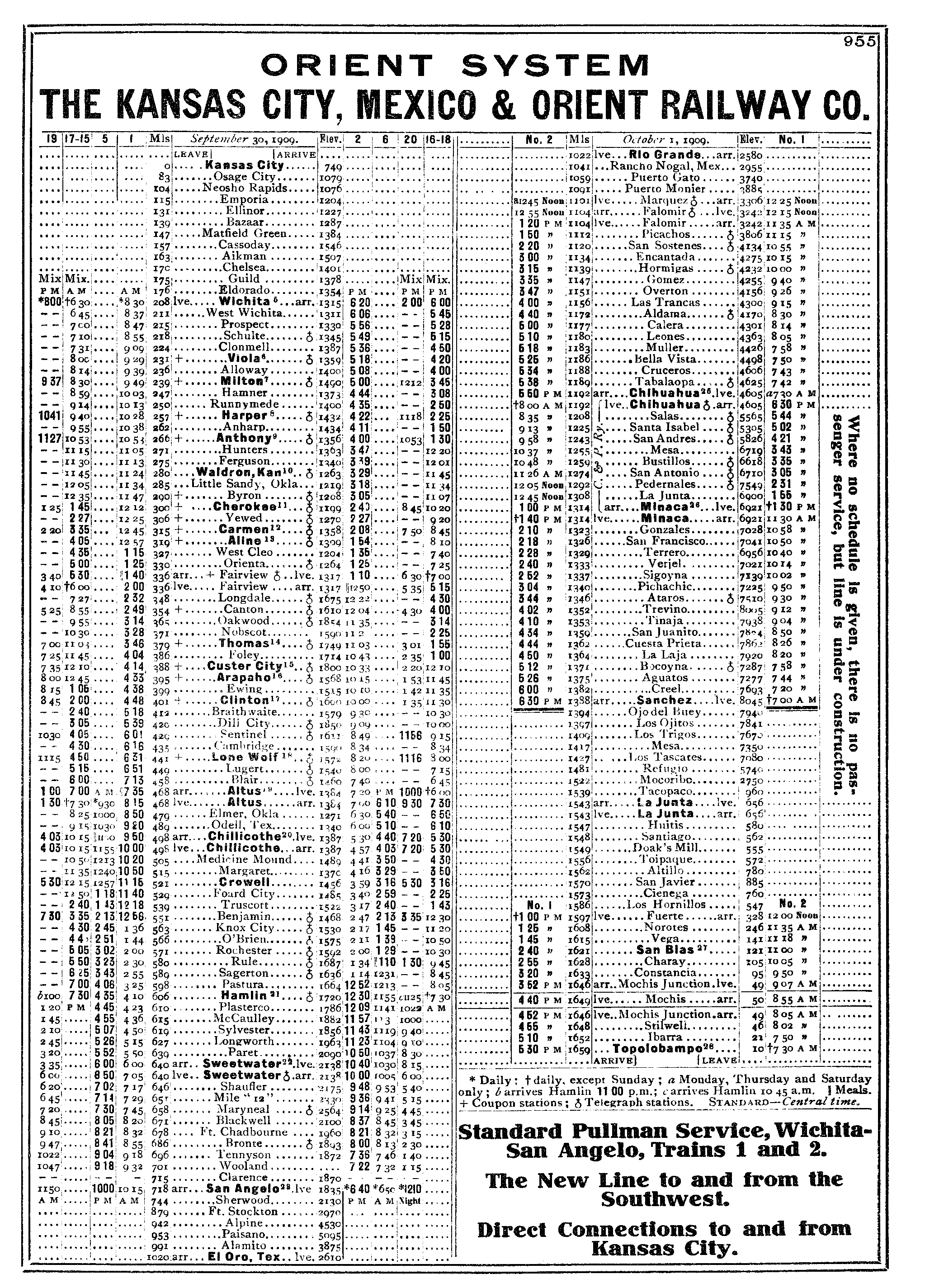The "Chepe Express" (Train): Map, Timetable, Route
Last revised: February 25, 2025
By: Adam Burns
The Chepe Express is the latest in upscale rail accommodations through Mexico's gorgeous Copper Canyon. Such services can be traced back to 1961 with the route's opening which immediately attracted tourists.
However, the route's most famous train was the first-class Sierra Madre Express, which operated from 1986 until 2009.
The canyon system (its deepest crevasse drops nearly 6,200 feet), which is larger than even America's world-renowned Grand Canyon, is actually comprised of six separate canyons formed by six different rivers.
These waterways drain into the Fuerte River which empties into the Gulf of California. The corridor boasts numerous natural and man-made wonders, which easily explains its popularity.
Many of the 86 tunnels and 36 bridges can be found on the Creel and Sufragio segment such as:
The El Lazo loop
The horseshoe-curved La Pera tunnel
The Chinipas Bridge soaring 335 feet over its namesake river
The 1,637-foot Agua Caliente Bridge crossing the Rio Fuerte River (the line's longest)
Tunnel 86 (bored through a mile of solid bedrock)
The information here offers just a brief glimpse of the Chepe Express and the history its route.
Route Map
History
The heritage of a rail line through Mexico's Copper Canyon can be traced back to American interests and, in particular, Arthur Edward Stilwell. Born in 1859 at Rochester, New York, he and his family had once been prominent members of society.
They fell on hard times and Stilwell was forced to find his own way, winding up as a traveling salesman. His business and societal yearnings never dimmed and, becoming involved in railroads, slowly worked his way up the ranks.
He was a firm believer in the "Air Line" concept, a railroad which contained the straightest possible alignment in connecting two points.
In 1889 he organized the Kansas City, Pittsburg & Gulf Railroad (KCP&G) to link Kansas City with the Gulf Coast by way of the shortest available route. It appeared his plan would succumb to the economic downturn following 1893's financial panic.
However, thanks to the help of George Pullman, the powerful businessman who built the Pullman Palace Car Company, Stilwell was provided $3 million and completed the railroad to Port Arthur, Texas (named for himself) with "Last Spike" ceremonies held at Beaumont on September 11, 1897.
Unfortunately, the KCP&G eventually did wind up in receivership (1899) and emerged as the Kansas City Southern Railway in 1900.
Ironically, the KCS remains one of America's seven Class I railroads today. With this setback it appeared Stilwell's involvement with railroads had come to an end.
However, as Keith Bryant, Jr. notes in his authoritative piece, "History Of The Atchison, Topeka & Santa Fe Railway," the man refused to fold and was working on his next adventure within a year.
That particular project had been the long sought ambition of many promoters, to construct the shortest transcontinental line from the Midwest to Pacific coast (1,600 miles).
To accomplish this, a railroad through Mexico was required whereby port facilities would be established at Topolobampo, Sinaloa along the Gulf of California.
The ultimate goal was to beat out Los Angeles, San Diego, and San Francisco for the China, India, and Japanese trade (primarily corn, wheat, and manufactured goods). While Stilwell claimed his idea was the first, such a proposal had actually been discussed for at least twenty years.
Kansas City, Mexico & Orient Railway
Without his own monetary means, Stilwell secured help from several Englishmen and local Kansas City businessmen.
The railroad was known as the Kansas City, Mexico & Orient Railway (KCM&O), incorporated on April 30, 1900 and officially chartered the following day.
Also known as "The Orient Route," it was built in segments with Stilwell hoping to later connect the separate sections.
Leaving Kansas City, it would pass through central Oklahoma at Fairview and then cross the Red River at Diaz; next, it would travel through Sweetwater, Texas and San Angelo before arriving at the Mexican border at El Oro along the Rio Grande River.
From there it wound its way through Chihuahua, Chihuahua (Mexico) and finally terminated at Topolobampo, Sonora. The Mexican segment was the most difficult where engineers had to contend with the very rugged mountains of the Sierra Madre Occidental.
Stilwell managed to finish five separate segments:
- Emporia-Cassoday, Kansas
- Wichita-Diaz, Texas
- Knox City-San Angelo, Texas
- Hormigas-Arapanapochic, Chihuahua
- Laguna-Topolobampo, Sonora
Altogether, the KCM&O operated 735 miles in America and another 320 in Mexico.
Timetable
Unfortunately, funding for the remainder could not be secured and the project struggled, eventually entering receivership in 1912.
The bankruptcy persisted for over a decade and the railroad's fortunes remained uncertain as late as 1928. The company's receiver was William T. Kemper who did his best at keeping the struggling operation afloat, despite efforts by creditors to see the entire affair liquidated.
He attempted to woo several major carriers like the Chicago, Burlington & Quincy; Chicago, Rock Island & Pacific; Missouri Pacific; and Southern Pacific.
None showed interest and even the United States Railroad Administration, which nationalized the industry during World War I, initially saw no value in the property. Without a through corridor, the KCM&O was of little use.
Then, the Santa Fe became interested, in part thanks to the KCM&O's growing petroleum business; by 1927 roughly 50% of its freight traffic was derived solely from oil. The AT&SF saw this business as quite lucrative.
It would not only bolster its operations in Texas but also prevent a competitor from potentially opening another transcontinental corridor. It acquired the KCM&O in 1928 for $14 million.
The AT&SF was disinterested in the Mexican property, selling it to Benjamin Francis Johnson, a sugar plantation owner based in Sinaloa, for $600,000, which included a $900,000 mortgage. He was unable to pay the remainder, and the Mexican government took over the property in 1940.
Ferrocarril Chihuahua al Pacífico
The Santa Fe quickly completed its segments but Mexico was much slower. The $88 million program was finally launched in 1958 under the direction of new Mexican president Adolfo Lopez Mateos.
Through his persistence, the railroad was finished on November 20, 1961.
The Santa Fe and Ferrocarril de Chihuahua al Pacifico (a component of the state-owned Mexican National Railways, or FNM) did interchange some freight through the Presidio gateway although it never proved the major transcontinental corridor Stilwell had hoped.
In an interesting twist, a new source of business sprang up when the line's breathtaking scenery began attracting an increasing number of tourists.
Today, Ferrocarril de Chihuahua al Pacifico is still in operation albeit as part of Ferromex, Mexico's largest private railroad.
Current Service
In an article entitled, "Mexico's New Copper Canyon Train Chases Upscale Clientele," from Trains Magazine's News Wire, released on March 8, 2019, the Chepe Express became the Copper Canyon's newest excursions when it debuted on May 17, 2018.
During its first year the train attracted about 19,000 visitors. It currently offers two levels of service; Executive (First) Class and Tourist Class. Both are modestly priced.
 An historic system map of the Kansas City, Mexico & Orient Railway, circa 1910. Author's collection.
An historic system map of the Kansas City, Mexico & Orient Railway, circa 1910. Author's collection.The train, operated by Grupo Mexico (owner of Ferromex) runs year-round and covers 406 miles from Chihuahua to Los Mochis (near Topolobampo), and of course features the very scenic Copper Canyon component which is comprised of about 248 miles south of Creel.
The company states its busiest time are the weeks near Easter and Christmas as well as the summer season from July through August.
They also recommend that anyone interested in the trip during these times book their journey at least four months in advance. Because the excursion can be made in a single day there are no sleepers attached to the Chepe Express.
The train includes a total of six cars; its services range from snack and drink bars to dining and dome service!
Aside from the train you can also take advantage of a range of other fun activities like a cable car ride in Divisidero, historic sites at El Fuerte, and fine dining in Los Mochis.
In his article, "A Copper Canyon Odyssey: Aboard Classic Postwar U.S. Passenger Cars, Travelers Experience Mexico's Most Spectacular Train Ride" from the February, 1997 issue of Trains Magazine, author Karl Zimmermann describes another interest aspect of this trip, interaction with the native Tarahumara (or Rarámuri) Indians who have inhabited the Copper Canyon region for many centuries.
While shy and reserved their wares and handcrafted goods can be purchased at various stations.
Recent Articles
-
Washington Thomas The Train Rides
Dec 21, 25 04:57 PM
This article will take you on a detailed journey through A Day Out With Thomas events held in Washington, offering insights into what makes this experience extraordinary for families and railroad enth… -
Pennsylvania Thomas The Train Rides
Dec 21, 25 03:52 PM
"A Day Out With Thomas” train rides offer a unique opportunity for children and their families to engage in a magical and memorable experience, setting the stage for a full day of fun and adventure. -
Illinois Thomas The Train Rides
Dec 21, 25 12:30 PM
In Illinois, the "A Day Out With Thomas" event offers a unique chance for families to immerse themselves in the enchanting world of Thomas and friends, creating memories that last a lifetime.




